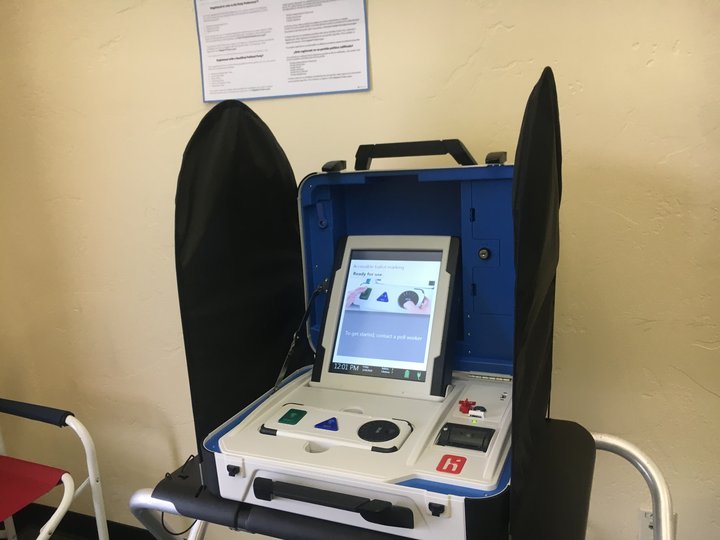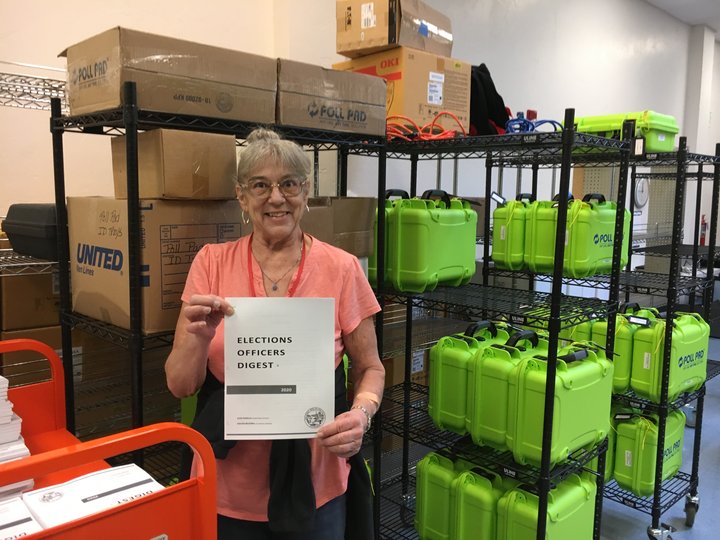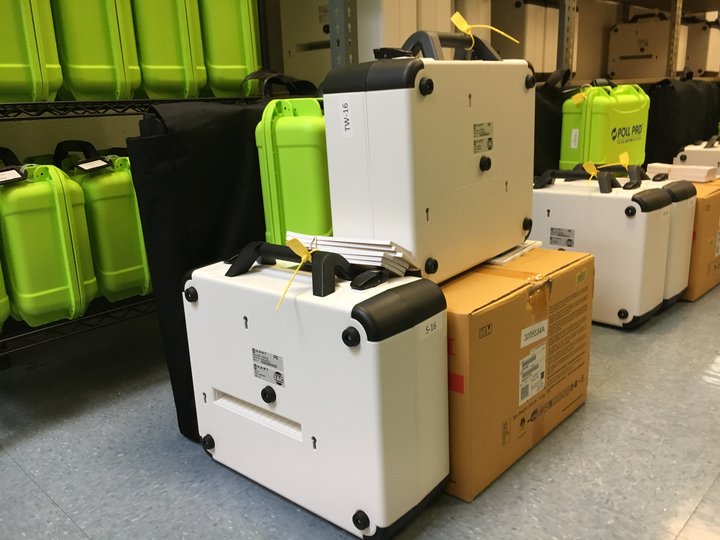
A new voting machine for voters with impairments. Photos by Freddy Brewster
###
Next Tuesday is voting day here in Humboldt County, where voters will have the ability to pick their presidential faves, select their choice for county supervisor in Districts 1 and 2, and decide whether or not they want to give more money to the Arcata Fire District or the Eureka City Schools, among other issues.
The March 3 ballots will be counted on brand new voting machines that are all geared up, tested and good to go for next week’s election. The new machines cost around $900,000, with a significant portion of that being picked up by the state. They consist of 55 scanners to tally the votes and 55 voting machines to assist voters with a number of impairments, and they’re from HART InterCivic, the same company that previously provided Humboldt County the tools to tally votes.
Humboldt County got new voting machines for a few different reasons. Back in February of 2019, California Secretary of State Alex Padilla announced that counties statewide must update their voting machines in order to “strengthen the security of California’s election infrastructure.” The old machines were also nearing the end of their time, and some manufacturers stopped making parts for them, and so repairs were getting to be a bit costly. Another reason why Humboldt got new voting machines is because of those dang Russians.
Hart InterCivic was provided with electronic poll books by a company named VR Systems, a Florida-based voting systems vendor. Back in 2017, The Intercept published a memo from the National Security Agency stating Russian military intelligence used a spear-phishing campaign to hack into VR Systems. This doesn’t mean the old Humboldt system was hacked and no evidence has been brought forth to say that it was the case. But to calm any panic and to be sure, we got new machines.

Kelly Sanders
Kelly Sanders is the clerk/recorder/registrar of voters for Humboldt County. Sanders told the Outpost that poll workers will start picking up the new machines this Saturday and begin installing them at the 50 or so precincts around the County. She said she decided to stick with the same company because of the familiarity poll workers had with the previous system.
“We really liked the features and the familiarity,” Sanders said. “We thought it was a good transition for voters and poll workers to continue [with Hart] because of the familiarity.”
The new system was tested three times to ensure accuracy. Sanders said the first round of testing happened as soon as the new machines arrived in Humboldt in what is called an “acceptance test.” A second and third round of testing was performed to test the accuracy of the new machines by premarking ballots and knowing what the outcome will be and then sending them through the machines.
“The expected results were achieved,” Sanders said.
As of Feb. 24, Humboldt has 79,171 registered voters for this year’s Presidential Primary, according to County data. So far, the County has processed 15,702 mail-in ballots, leaving a large chunk headed to the polls on Tuesday. To help ease those voters through the process are about 450 poll workers.

Linda Bartlett, a poll worker for 45 years
The poll workers pick up a kit of election-related tools for each precinct. Each kit has three briefcases that hold the ballot scanner, a Touch Writer machine and an iPad-like machine that holds the roster of voters. They also pick up a printer, a collapsible ballot box, a number of voting stands and a locked tub full o’ ballots.
“The ballots look very similar to the previous system,” Sanders said.
All of the briefcases and the container with the ballots inside are secured with a tamper-proof seal that is checked at each step of the way. The ballots themselves are even in a sealed tamper-proof bag. Unlike some other states, California requires a paper ballot that can be checked to verify election results. State law also requires a mandatory recall of 1 percent of the vote for each county.

The kit of elections-related tools
Once the polls close at 8 p.m., Sanders said that is when the tabulation of results begins, with the first numbers put out by the County being the mail-in ballots. The counting process is open to the public and takes place behind in a secured and locked area that requires visitors to sign in and out.
“We get a number of observers on election night,” Sanders said from within the vote-counting area. The Outpost was able to witness democracy in action today as a large stack of mail-in ballots were run through a scanner within the secured area.
As the ballots are fed through the scanner, a number of things happen: Both sides of the ballot are scanned, the precinct is identified, the party affiliation is identified and the results are tallied — but only shown on a separate computer specifically used for tabulating the results. The Outpost witnessed 137 ballots processed through the machine that were then sealed in a bag labeled “Cache 77.”
Sanders started working in the elections office back in 2005. Back then, she said, precincts were able to fax in their results, but that went away in the late 2000s — things are much more secure these days. None of the machines are connected to the internet and the results are tallied on a thumb drive stored within the machine itself. In order to take the thumb drive out, a key is required and the latch securing the thumb drive inside the machine is sealed with a tamper-proof indicator.
Once the polls are closed and all of the ballots are scanned, the ballots and the scanners are brought to the elections office, where the thumb drive is taken out and the results are uploaded onto the tabulating computer within the secured area.
When asked how can the County ensure voter security, Sanders pointed to the work being done by a local group of volunteers, the Elections Transparency Project.
“We allow the ETP to come in and do a scan of the election ballots,” Sanders said. “It is a complete audit of the election process and having that second audit gives voters confidence.”
The group got its start in June 2008 and quickly grew to prominence. In Nov. 2008, ETP found 197 mail-in votes had been dropped from the final ballot count. Wes Rishel is the Technical Lead of the ETP, and said there are five official members with about three to five volunteers.
“It is a massive job to run 100,000 to 200,000 ballots through a scanner,” Rishel told the Outpost.
The ETP runs on a tight budget and utilizes recycled computer parts. Rishel said that in order to audit the county’s results, ETP runs two sets of numbers. The first is a quick run through of how many people voted. The second number is to verify the actual votes themselves.
“To get to that final count, it takes a minimum of a couple of weeks,” Rishel said.
He said there are essentially two problems that can occur in the vote tabulating process: machine malfunction (nothing nefarious) and deliberate malfunction like hacking. When asked how he feels about electronic voting or voting over the internet, he busted out a laugh.
“It sucks,” Rishel said. “There’s no piece of paper to look at, it’s crazy. There’s no ability to manually recount. You can’t physically go and look at what [people] voted on.”
Rishel is retired and picked up the “hobby” of ensuring democratic accuracy back in 2016. When asked why he decided to join the ETP, he laughed and said, “You only have to look at the news to understand that.”
“I think we are as safe as you can be here,” he said, “but these days you have to keep your eye open and stay vigilant.”
CLICK TO MANAGE